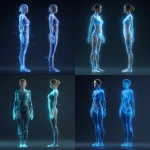Explore the Best AI Image Gallery

Beyond Pixels: How Edge Computing is Reimagining Creativity
The creative landscape is on the cusp of a paradigm shift, driven by the burgeoning power of edge computing. This decentralized processing model, which brings computation closer to data sources, is poised to revolutionize how artists, designers, and innovators conceive, create, and interact with their work. From immersive experiences to real-time collaborative workflows, edge computing is unlocking a realm of possibilities that transcend traditional creative boundaries.
Applications at the Edge of Creativity
Edge computings ability to process data in real time opens up a myriad of applications within the creative industry:
- Immersive Art Installations: Imagine interactive art pieces that respond to viewer movement and emotions, generating dynamic visuals and soundscapes. Edge computing enables this by processing sensor data from wearables or environmental sensors on-site, creating truly personalized and engaging experiences.
- Real-Time Collaborative Design: Designers can collaborate seamlessly on projects regardless of their location. Edge computing facilitates real-time design modifications and feedback, fostering a more fluid and efficient creative process.
- Personalized Content Creation: With edge computing, artists can tailor content to individual preferences in real time. Imagine music compositions that adapt to your mood or stories that evolve based on viewer choices.
- Augmented Reality (AR) Experiences: Edge computing powers seamless and responsive AR overlays, enriching our interactions with the physical world. Artists can use this to create interactive exhibits, immersive storytelling, or even virtual fashion shows.
Ethical Considerations on the Horizon
As edge computing permeates creative workflows, several ethical considerations emerge:
- Data Privacy and Security: Edge devices collect vast amounts of user data. Ensuring robust security measures and transparent data handling practices is paramount to protect individual privacy.
- Algorithmic Bias: AI algorithms used in edge computing can perpetuate existing biases if not carefully designed and monitored. Its crucial to ensure fairness and inclusivity in creative outputs generated by these systems.
- Accessibility and Equity: The benefits of edge computing should be accessible to all, regardless of their technical expertise or socioeconomic status. Bridging the digital divide is essential to foster equitable access to creative tools and opportunities.
Future Trends Shaping the Creative Edge
The evolution of edge computing will continue to reshape the creative industry. Some key trends to watch include:
- 5G and Beyond: Faster network speeds will enable real-time collaboration on a global scale, fostering new forms of cross-cultural artistic expression.
- Edge AI Advancements: More sophisticated AI algorithms running at the edge will empower creatives with intelligent tools for generating, editing, and personalizing content.
- Democratization of Creativity: Edge computing will empower individuals with accessible tools to create and share their artistic visions, fostering a more inclusive and diverse creative ecosystem.
Conclusion
Edge computing is not merely a technological advancement; its a catalyst for a creative revolution. By empowering artists, designers, and innovators with unprecedented capabilities, edge computing will redefine the boundaries of creativity, ushering in a new era of immersive experiences, personalized content, and collaborative artistry.
](https://images.ai-img.art/thumbnails/150/27af9f0bb8b7c7d503263849abaf3ede0e1acd1c8e0bdaba4700f845a674a0fc.webp)







](https://images.ai-img.art/thumbnails/150/3d91370d58b2f68867187ea56dc69c37d746fdadd44b521d87b1bf1df5d10f40.webp)



](https://images.ai-img.art/thumbnails/150/26c257403e31dee6746c78e38bceb7def6011d04664049ef156f64a1c5497d44.webp)















](https://images.ai-img.art/thumbnails/150/17edcb4f51c616e1278d716b510145bbc041556f71d621d2895f134892303315.webp)







](https://images.ai-img.art/thumbnails/150/e0118b29fe5cfc2e6592413bab22001f9af64b4b69c6ec903940c927cde44197.webp)












